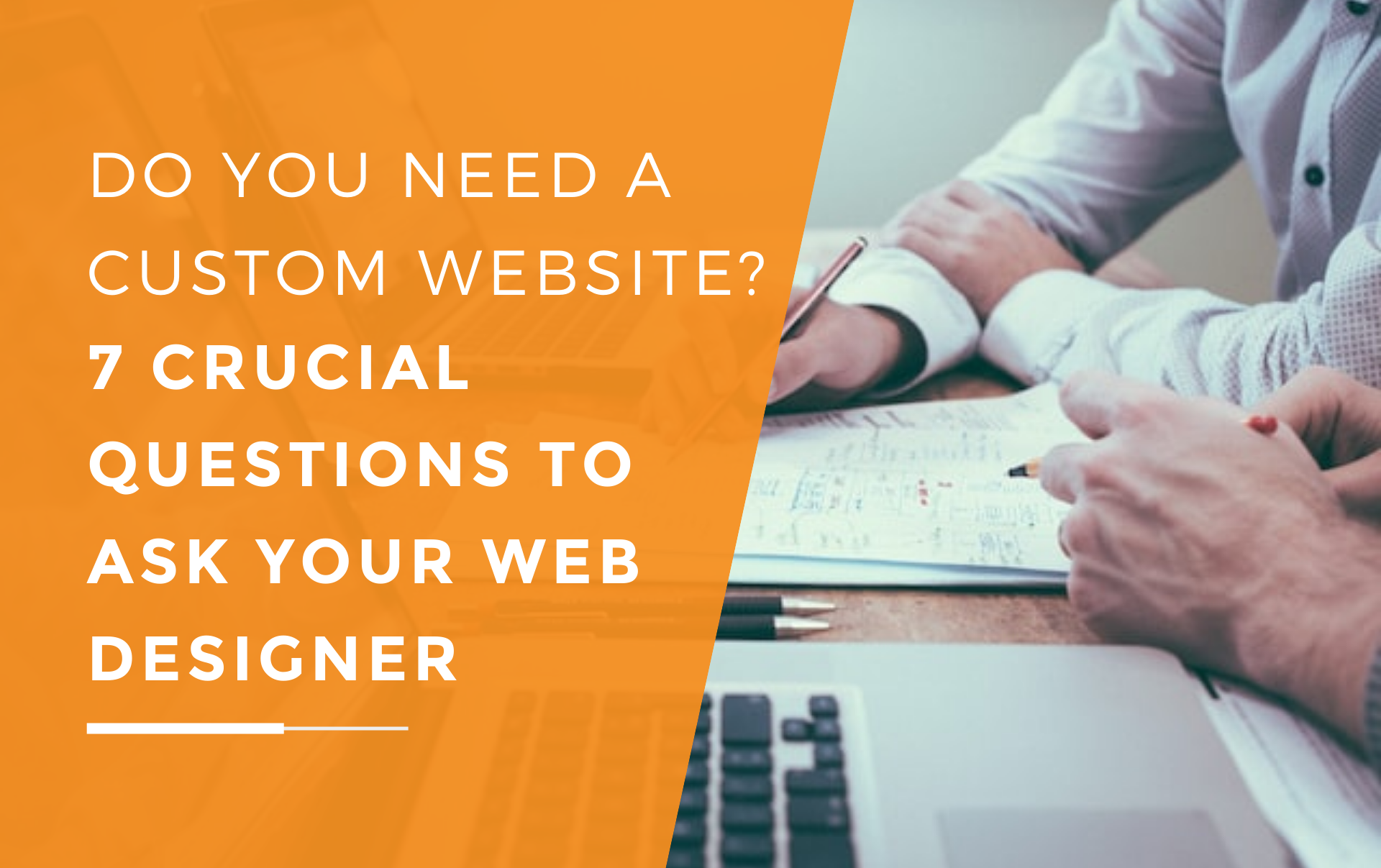Where Your Business Is Losing Website Visitors (And How To Stop It)
by Leanne Mordue on 14-Aug-2022 10:52:00

A poorly designed website can break a business just as surely as a well-considered site can transform a business’s fortunes online. If you’re not getting as many leads online as you should, or are finding it tough to make sales, it could be that your website has become more of a liability than an asset.
In a previous article we looked at the main reasons why websites underperform – including slow loading speed, confusing navigation etc – either discouraging visitors from clicking on your site to begin with, or making a swift exit.
Assuming for now that these performance issues are addressed or do not apply to your website, we would like to look in more detail at the specific weak points that could be losing you leads – and how to strengthen these key areas.
What are your website’s weak points?
1. Too Much Information
The key to optimising your website for conversions is to make your content as accessible as possible, with clearly defined arguments and well-organised information that can be accessed quickly by visitors without much effort. Unfortunately, this requirement runs counter to the trend in website design towards longer and far more detailed webpages, seemingly endlessly scrolling from one issue to the next.
While your web content should be informative and detailed, there is a danger of providing too much information on individual pages. Visitors can feel overwhelmed or, at best, that they need to take their time to understand all the content they are presented with – deterring enquiries and scaring away many potential customers.
The solution? Keep each page on your website strictly focused on one service, one argument, or one product category. If you have a lot to say, break your content down into multiple pages, with a top-level page summarising the subject, and various subpages (and blog posts) that explore elements of the category in further detail. This makes it easier to optimise individual pages for one or two keywords, leading to greater search visibility, too.
2. Tab Overload
As a website owner, you want to make the user experience of visiting your website as intuitive, straightforward, and uncomplicated as possible. A big part of this is not clogging your visitors’ web browsers down with a succession of new tabs and pop-up windows. When a visitor navigates around your site, unless you have good reason to do otherwise, have the site open the new page in the same browser tab. Exceptions to this rule are checkout pages, but in most other circumstances, new tabs direct visitors away from your site by making it harder to navigate back to the previous page. Visitors become more likely to leave your site in frustration before making contact.
3. Difficult To Contact You
It may seem like an obvious point, but it is essential to provide your website visitors with a clear and easy means of contacting you. Many websites still use a single contact page as their point of contact, deterring enquiries from any other page.
Others force their visitors to jump through hoops before they can make contact – e.g. by making them sign up for an account, provide too many irrelevant personal details, or wade through complicated CAPTCHA processes to prove they’re not robots. What this does is create barriers that the customer needs to traverse before they can access the information they need, and many won’t stick around to do so.
4. No Need To Contact You
A Frequently Asked Questions (FAQs) page is a treasure trove of information for potential customers and can attract website visitors by addressing specific search queries relating to your products and services on Google. However, don’t give away too much in your FAQs page – the point being, remember, to encourage customer enquiries, not to give them everything they need at once so they can leave and go straight to a competitor.
5. Content Is Inconsistent Or Out Of Date
An interested website visitor will visit multiple pages of your site, with those that are most interested paying close attention to your web content. Like most business websites, yours may have evolved organically, with new pages added and content created and updated at different times.
This inevitably creates opportunities for out of date and inconsistent web content – especially regarding the services you currently offer, prices, accreditations, your business contact details, and your company name. These seemingly insignificant points (to you) will be glaringly obvious to visitors and could undermine trust and credibility in your business. Whenever you update your content or something about your business changes, make sure your entire website is updated to contain accurate and relevant information.
Sales-driven web design
A business website holds little value unless it generates leads that convert into customers. Our marketing-focused web design service has one purpose – to turn your website into a powerful lead generation asset for your business. To find out more about what you can achieve with a fully optimised website, please call 01332 215152 today.
Image source: Unsplash
- Inbound Marketing (SEO, PPC, Social Media, Video) (827)
- Strategy (366)
- Sales & CRM (195)
- Marketing Automation & Email Marketing (190)
- Business Growth (165)
- Website Design (160)
- Hubspot (138)
- Lead Generation (116)
- Google Adwords (99)
- Content Marketing (94)
- Conversion (51)
- Case Studies (47)
- News (47)
- Ecommerce (39)
- Webinars (34)
- SEO (25)
- AI (20)
- Events (19)
- LinkedIn Advertising (17)
- Video (17)
- Video Selling (15)
- Software training (13)
- Niche business marketing (11)
- The Digital Prosperity Podcast (10)
- Facebook Advertising (6)
- HubSpot Case Studies (5)
- January 2026 (1)
- December 2025 (15)
- November 2025 (6)
- October 2025 (17)
- September 2025 (16)
- August 2025 (14)
- July 2025 (14)
- June 2025 (5)
- May 2025 (19)
- April 2025 (15)
- March 2025 (13)
- February 2025 (13)
- January 2025 (8)
- December 2024 (2)
- November 2024 (4)
- October 2024 (21)
- September 2024 (4)
- August 2024 (8)
- July 2024 (14)
- June 2024 (16)
- May 2024 (25)
- April 2024 (15)
- March 2024 (18)
- February 2024 (5)
- January 2024 (10)
- December 2023 (6)
- November 2023 (10)
- October 2023 (13)
- September 2023 (12)
- August 2023 (14)
- July 2023 (13)
- June 2023 (14)
- May 2023 (15)
- April 2023 (13)
- March 2023 (14)
- February 2023 (13)
- January 2023 (15)
- December 2022 (13)
- November 2022 (6)
- October 2022 (8)
- September 2022 (22)
- August 2022 (15)
- July 2022 (13)
- June 2022 (16)
- May 2022 (14)
- April 2022 (16)
- March 2022 (17)
- February 2022 (11)
- January 2022 (8)
- December 2021 (6)
- November 2021 (7)
- October 2021 (11)
- September 2021 (10)
- August 2021 (7)
- July 2021 (7)
- June 2021 (4)
- May 2021 (4)
- April 2021 (1)
- March 2021 (3)
- February 2021 (5)
- January 2021 (4)
- December 2020 (7)
- November 2020 (6)
- October 2020 (5)
- September 2020 (9)
- August 2020 (18)
- July 2020 (17)
- June 2020 (17)
- May 2020 (10)
- April 2020 (21)
- March 2020 (24)
- February 2020 (21)
- January 2020 (12)
- December 2019 (23)
- November 2019 (12)
- October 2019 (14)
- September 2019 (16)
- August 2019 (15)
- July 2019 (13)
- June 2019 (6)
- May 2019 (8)
- April 2019 (4)
- March 2019 (2)
- February 2019 (2)
- January 2019 (2)
- December 2018 (3)
- November 2018 (24)
- September 2018 (11)
- August 2018 (9)
- June 2018 (3)
- May 2018 (6)
- April 2018 (14)
- March 2018 (12)
- February 2018 (16)
- January 2018 (15)
- December 2017 (15)
- November 2017 (18)
- October 2017 (23)
- September 2017 (19)
- August 2017 (28)
- July 2017 (27)
- June 2017 (25)
- May 2017 (18)
- April 2017 (17)
- March 2017 (16)
- February 2017 (17)
- January 2017 (14)
- December 2016 (21)
- November 2016 (27)
- October 2016 (25)
- September 2016 (16)
- August 2016 (20)
- July 2016 (19)
- June 2016 (14)
- May 2016 (20)
- April 2016 (24)
- March 2016 (22)
- February 2016 (28)
- January 2016 (27)
- December 2015 (28)
- November 2015 (19)
- October 2015 (9)
- September 2015 (12)
- August 2015 (5)
- July 2015 (1)
- June 2015 (10)
- May 2015 (3)
- April 2015 (11)
- March 2015 (14)
- February 2015 (15)
- January 2015 (12)
- December 2014 (2)
- November 2014 (23)
- October 2014 (2)
- September 2014 (2)
- August 2014 (2)
- July 2014 (2)
- June 2014 (7)
- May 2014 (14)
- April 2014 (14)
- March 2014 (7)
- February 2014 (2)
- January 2014 (7)
- December 2013 (9)
- November 2013 (14)
- October 2013 (17)
- September 2013 (3)
- August 2013 (6)
- July 2013 (8)
- June 2013 (4)
- May 2013 (3)
- April 2013 (6)
- March 2013 (6)
- February 2013 (7)
- January 2013 (5)
- December 2012 (3)
- November 2012 (2)
- September 2012 (1)
Subscribe by email
You May Also Like
These Related Blogs

Will A Website Really Benefit Your Business?
I would like to begin with these 6 facts: In 1953 the first colour television was introduced. In 1969, 16 years later, the first man landed on the moo …

Do You Need a Custom Website? 7 Crucial Questions To Ask Your Web Designer
If you’re looking for a custom website for your business, as opposed to a standardised template site, you will probably need to work with a web design …

Mail Order Brides, Pornography & Malware: How Website Hacks Can Hit Your Business
Cyber-attacks don’t just affect large banks and the NHS, they affect smaller businesses, too. Stats vary, but a 2020 UK Government survey of cybercrim …




